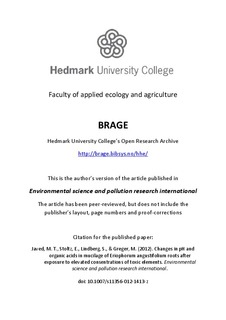Changes in pH and organic acids in mucilage of Eriophorum angustifolium roots after exposure to elevated concentrations of toxic elements
Original version
Javed, M. T., Stoltz, E., Lindberg, S., & Greger, M. (2012). Changes in pH and organic acids in mucilage of Eriophorum angustifolium roots after exposure to elevated consentrations of toxic elements. Environmental science and pollution research international. doi: 10.1007/s11356-012-1413-z 10.1007/s11356-012-1413-zAbstract
The presence of Eriophorum angustifolium in mine tailings of pyrite maintains a neutral pH, despite weathering, thus lowering the release of toxic elements into acid mine drainage water. We investigated if the presence of slightly elevated levels of free toxic elements triggers the plant rhizosphere to change the pH towards neutral by increasing organic acid content. Plants were treated with a combination of As, Pb, Cu, Cd and Zn at different concentrations in nutrient medium and in soil in a rhizobox-like system for 48-120 hrs. The pH and organic acids were detected in the mucilage dissolved from root surface, reflecting the rhizosphere solution. Also the pH of root-cell apoplasm was investigated. Both apoplasmic and mucilage pH increased and the concentrations of organic acids enhanced in the mucilage with slightly elevated levels of toxic elements. When organic acid concentration was high, also the pH was high. Thus, efflux of organic acids from the roots of E. angustifolium may induce rhizosphere basification.
Description
This is the postprint version of the article. The published article is available at www.springerlink.com
